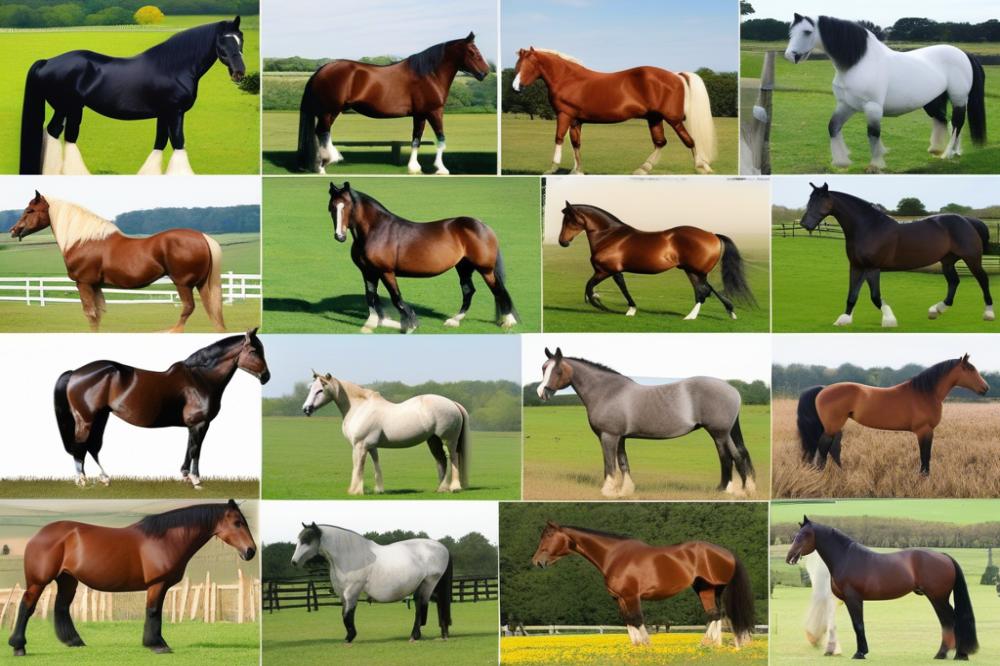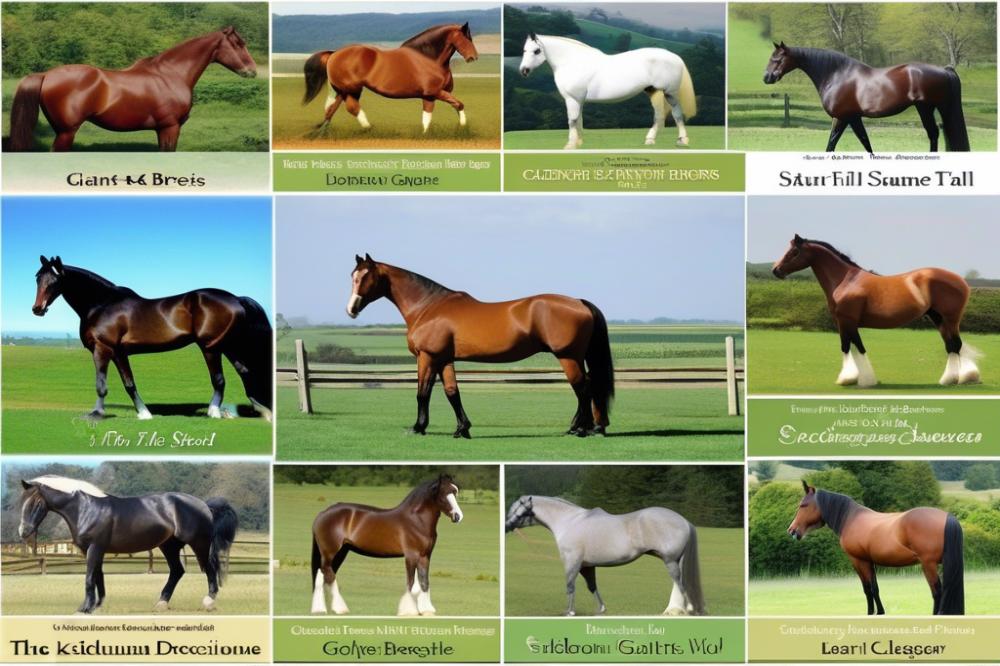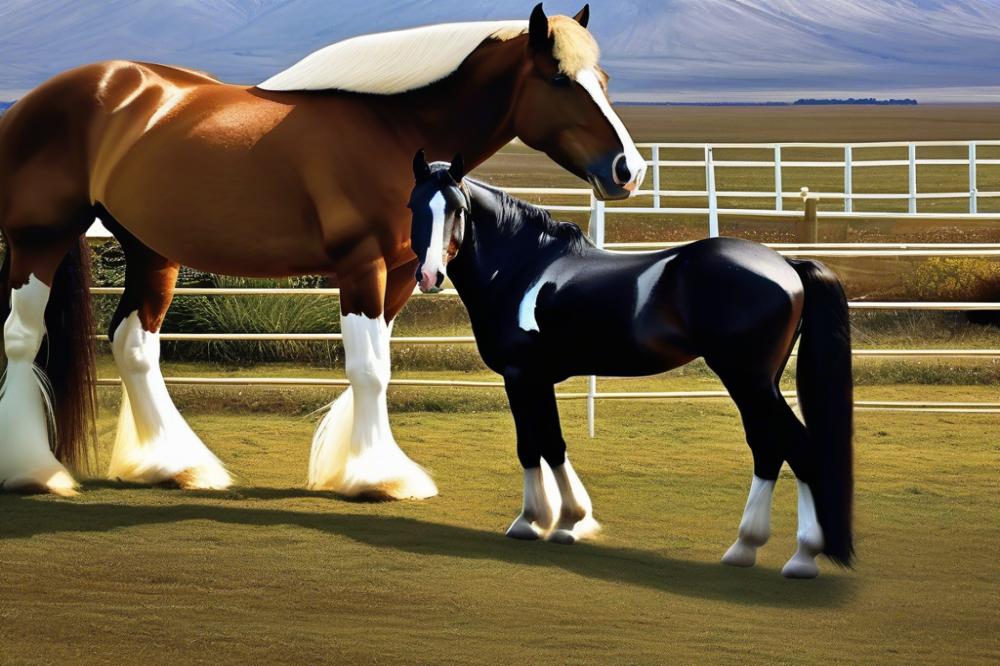The Towering Giants: Exploring the tallest horse breeds in the World
Introduction
Horses have long captured the human imagination. These magnificent animals come in various breeds, each with its own characteristics and history. From racing thoroughbreds to sturdy draft horses, the diversity in equine types reflects the needs and lifestyles of people throughout history. Yet, one aspect of horses particularly fascinates many: height.
Some horses grow to astonishing sizes. The tallest horse breeds stand out not just for their stature but also for their strength and beauty. Exploring these towering giants reveals more than just impressive measurements; it uncovers the unique qualities and capabilities that come with being a tall horse.
Height plays a significant role in the world of equines. In certain breeds, being taller can provide advantages in physical abilities such as pulling or carrying loads. Horses that reach impressive heights often serve essential roles in agriculture, tourism, and therapy. They also evoke admiration and awe in anyone lucky enough to see them up close. Learning about these extraordinary creatures can take us into the fascinating world of the tallest horse breeds and their remarkable stories.
Tallest Horse Breeds

Tall horses are impressive creatures. They often capture attention with their towering stature. Generally, a horse is considered tall if it stands at least 16 hands, which is about 64 inches at the shoulder. These horses typically have long legs, strong bodies, and a notable presence. Their height can contribute to their capabilities in various equestrian activities. Riders often find that taller breeds provide a different experience compared to shorter ones.
Several breeds stand out when discussing height. The Shire horse is among the most recognized. A well-bred Shire can often exceed 17 hands. Then there’s the Clydesdale, famous for its strength and notable feathering on the legs. They also reach impressive heights, averaging around 16 to 18 hands. Another breed worth mentioning is the Thoroughbred. While most known for racing, they can also be quite tall, often hitting the 16 to 17 hands range.
Draft horses are typically larger, needing strength for heavy work. Their size aids them significantly in agrarian roles. The Belgian horse is another giant. This breed is not only tall but also known for its muscular build. Each breed mentioned has unique qualities that contribute to its height and purpose. Tall horses present certain challenges and advantages in care and management.
Understanding the characteristics of these breeds is essential. Each horse requires special attention based on its height and build. Knowing the needs of tall horses helps in their proper handling. The relationship between horse and rider can change, influenced largely by the horse’s size. This adds depth to the bond formed between them.
Breeders have emphasized size in cultivating these majestic animals. Selective breeding has played a crucial role in ensuring that height is maintained within these lineages. This results in a variety of large but distinct breeds. Enthusiasts of tall horses appreciate not just their size, but how much they enrich the experience of horseback riding and working with animals.
The Shire Horse

History and Origin of the Shire Breed
The Shire horse has deep roots in England. Its history dates back to the 17th century. Initially, these horses were bred for heavy work. Farmers relied on them for plowing and pulling carts. The breed was known for its strength and size, helping transport goods and agricultural products. Over the years, the Shire gained recognition not just for its brawn but also for its grace. They became popular in agriculture and firefighting. Today, their legacy continues as they symbolize hard work and reliability.
Average Height and Weight
Shire horses are impressive creatures. They typically stand between 16.2 and 17.2 hands tall, making them quite tall among horse breeds. Some individuals can even exceed 18 hands. Weight can vary significantly, but it generally ranges from 1,800 to 2,400 pounds. Their large frame lends itself well to labor but also contributes to their majestic presence.
Key Traits and Uses
Strength and calmness define the Shire horse. They possess powerful muscles, making them excellent for farm work and hauling heavy loads. Their temperament is generally gentle and friendly, which makes them suitable for families. Riders often appreciate their easygoing nature. Beyond work, many people utilize Shires for riding and pulling carriages in parades or events. Additionally, their stature creates a striking image that captivates onlookers.
Famous Shire Horses
Several Shire horses have gained fame over the years. One such notable horse was the “Big Jake,” who was recognized for holding the title of the tallest horse in the world. He stood an astonishing 20.2 hands tall. Another name that stands out is “Sampson,” who was recorded in the 19th century and reached 21.2 hands. These horses have helped to solidify the Shire’s reputation and allure. Their extraordinary size and gentle demeanor leave a lasting impression on those who encounter them.
The Clydesdale
Background of the Clydesdale breed
Clydesdales originated in Scotland during the 18th century. They were bred for heavy farm work in the region around the River Clyde. Farmers valued these horses for their strength. They assisted in pulling plows, hauling timber, and transporting goods. Over time, they became associated with breweries, especially Anheuser-Busch. Their striking appearance and gentle demeanor contributed to their popularity.
Height range and physical attributes
This breed typically stands between 16 and 18 hands tall. They are muscular, with a robust frame that showcases their power. Their coat is often bay, with white markings on the face and legs. Long, flowing manes and feathery lower legs add to their distinct look. Clydesdales are not just about size; they also possess grace and elegance. This combination makes them visually impressive.
Role in agriculture and culture
In agricultural settings, Clydesdales played an invaluable role for many years. Farmers relied on them for plowing fields and transporting heavy loads. Their gentle nature made them suitable for families. Clydesdales transitioned into the spotlight with their use in advertising. The Budweiser commercials popularized these magnificent horses, turning them into a cultural icon. They symbolize strength and reliability in popular culture.
Notable Clydesdale facts
One interesting fact is that their average weight ranges from 1,800 to 2,300 pounds. These animals have a long lifespan, often living 20 years or more. Their unique gait allows them to cover ground efficiently despite their size. Owners often keep a close eye on their health, as they can be prone to certain conditions. Clydesdales are well-known for their friendly disposition, making them great companions. Additionally, they participate in parades and shows, showcasing their beauty and charm.
The Percheron
Origins of the Percheron breed
The Percheron breed traces its roots to the Le Perche region of France. This area is known for its sturdy horses, which were used for farming and transportation. These animals became popular in the 1800s. They were bred for strength, making them ideal for draft work. Crossbreeding with Arabian horses introduced some unique traits. As a result, Percherons gained a noble appearance along with their powerful build.
Average height and build
Typically, a Percheron stands between 15.1 and 17 hands high. Their muscular build and solid structure contribute to their impressive presence. A well-defined neck complements their broad chest and strong legs. Coat colors primarily include gray and black but there can be variations. This breed showcases power and grace, making it a favorite among draft horses.
Versatility and work capabilities
Percherons excel in various roles. They were once the backbone of farming and heavy hauling. These horses adapt well to both work and leisure activities. Many equestrians use them for riding, driving, and even competitive events. Their good temper and intelligence increase their popularity. Percherons can easily handle laborious tasks, showing remarkable endurance.
Popularity and modern uses
Today, Percherons are sought after for their versatility. Their strong work ethic suits them for multiple purposes. They can be seen in parades and exhibitions, showcasing their beauty. In farms, they help with tasks requiring great strength. Many people also love them for recreational riding. As their reputation grows, new enthusiasts are drawn to this majestic breed.
The Belgian Horse
History and Development of Belgian Horses
The Belgian horse has a rich history dating back to the Middle Ages. These majestic animals were originally bred for work in agriculture. Farmers valued their strength and stamina. Over time, they became essential for heavy farm tasks. Their lineage includes crossbreeds from several European horses. The breed was formalized in Belgium in the 19th century. Today, the Belgian horse is recognized worldwide for its impressive size and muscular build.
Height Specifications and Features
Belgian horses stand among the tallest breeds of horses. Adults typically reach a height of 16.2 to 17.3 hands tall. Many may even exceed this average. Their bodies are strong with broad chests and powerful legs. Most have a distinctive draft horse appearance. Coat colors often vary from chestnut to bay, sometimes featuring white markings. The mane and tail tend to be thick and flowing, adding to their striking presence.
Typical Uses in Farming and Shows
Common tasks for Belgian horses include pulling heavy loads and plowing fields. Many farmers rely on these horses for everyday work. They also participate in local horse shows where they demonstrate their strength and beauty. In competitions, their calm demeanor helps them shine. Enthusiasts enjoy showcasing these gentle giants in parades and exhibitions. Their presence often captivates audiences, making them a favorite at fairs.
Comparison with Other Draft Breeds
When compared to other draft breeds, Belgian horses stand out for their size and temperament. Other breeds, such as the Clydesdale or Percheron, may offer different appearances. Some are more refined, while others exhibit unique color patterns. Belgians, however, are known for their consistent strength. This trait makes them ideal for various tasks. While Clydesdales have distinct feathering on their legs, Belgians often have a cleaner look. Different draft breeds serve unique purposes in agriculture and recreation, yet the Belgian remains a stalwart choice.
The Suffolk Punch
Overview of the Suffolk Punch breed
The Suffolk Punch is a remarkable breed known for its strength and heavy build. Originating in England, this horse has played crucial roles on farms and in agriculture. It is a draft breed, meaning it was bred primarily for work rather than speed.
Unique characteristics and average height
Typically, Suffolk Punch horses stand between 16 to 17 hands high. Their bodies are muscular, with powerful legs that can handle tough labor. The coat usually comes in a rich chestnut color. Males and females share similar traits, making them distinguishable and impressive. Their calm demeanor makes them gentle giants among horse enthusiasts.
Historical significance and function
Historically, these horses were essential in farming communities. They pulled plows and worked in fields, helping farmers cultivate crops. The breed became integral to rural life in England from the 16th century onward. As agricultural practices evolved, the Suffolk Punch remained a reliable companion for many working families.
Efforts in conservation
Recently, there have been efforts to conserve this beloved breed. The Suffolk Punch Trust, along with various organizations, aims to protect and promote their numbers. They recognize the breed’s importance in preserving agricultural heritage. These initiatives provide education about the breed and its historical context, inspiring a new generation of horse lovers to appreciate this incredible animal.
Comparative Analysis of Draft Horse Breeds
In the world of horses, some breeds stand out for their impressive height. Draft horses are the giants that often capture people’s attention. Breeds like the Clydesdale, Shire, and Percheron showcase remarkable size. Spanning various regions, these horses share several characteristics but also exhibit distinct differences.
Clydesdales are known for their striking feathering and muscular build. Shires, on the other hand, can be even taller, often reaching towering heights. These differences in appearance influence their roles in society. Percherons bring a balance of strength and elegance, making them versatile workhorses.
Height impacts functionality significantly. Taller horses often carry heavier loads. However, their size may affect agility. For instance, a Clydesdale can pull a wagon, but quick turns are not its strong suit. This means that while they can serve in various roles, particulars like terrain and task requirements matter greatly.
Equine giants play essential roles in society. Historically, they were bred for heavy labor, hauling goods and plowing fields. Today, their use has shifted but remains relevant. They are popular in parades, where their size and grace create a stunning visual. Additionally, many people appreciate their gentle nature, which often makes them great companions.
Different breeds achieve prominence for various reasons. Their sheer size commands respect and admiration. However, with great size comes great responsibility. Owners need to consider their care requirements, diet, and exercise. Each breed brings unique traits that owners and trainers must understand.
Wrapping Up the Journey Through Equine Giants
We have explored some of the tallest horse breeds in the world, including the majestic Shire and the impressive Clydesdale. These breeds captivate horse lovers with their towering stature and gentle temperament. Each horse carries a legacy that reflects not only their size but also their strength and versatility.
Preserving these breeds is crucial for maintaining the diversity of equine genetics. As they face challenges from modern agricultural practices and changing lifestyles, protecting their existence becomes ever more important. Efforts in conservation can help ensure that future generations experience the wonder of these magnificent animals.
Tall horses hold a special place in equine history. They symbolize power and grace, representing hardworking breeds that have served humanity for centuries. These incredible creatures are not just about being tall; they also represent commitment and companionship. In every stride, they bear the stories of their pasts and the hopes for our future with horses.



